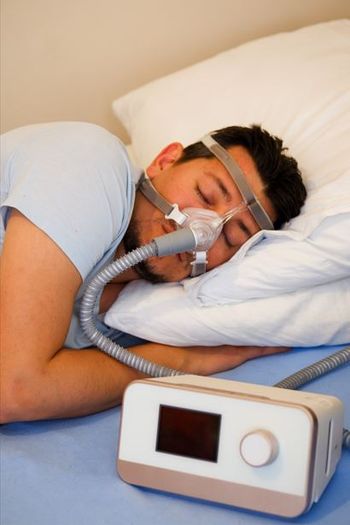
The Journal of Respiratory Diseases
- The Journal of Respiratory Diseases Vol 5 No 5
- Volume 5
- Issue 5
Clinical Citations: Obstructive sleep apnea and cardiovascular events: Can CPAP reduce risks?
Severe obstructive sleep apnea- hypopnea syndrome (OSAHS) increases the risk of cardiovascular events in men, according to a large, prospective, controlled study by Marin and associates. Fortunately, this study also demonstrated that treatment with nasal continuous positive airway pressure (CPAP) reduces this risk.
Severe obstructive sleep apnea- hypopnea syndrome (OSAHS) increases the risk of cardiovascular events in men, according to a large, prospective, controlled study by Marin and associates. Fortunately, this study also demonstrated that treatment with nasal continuous positive airway pressure (CPAP) reduces this risk.
The study included 403 men with untreated mild to moderate OSAHS, 235 men with untreated severe OSAHS, 372 men with OSAHS who were treated with nasal CPAP, 377 men who snored but did not have OSAHS, and 264 healthy men. The incidences of fatal and nonfatal cardiovascular events were significantly higher in patients with untreated severe OSAHS than in the other groups.
A multivariate analysis that adjusted for potential confounding variables indicated that untreated severe disease was associated with increased risk of both fatal (odds ratio [OR], 2.87) and nonfatal (OR, 3.17) cardiovascular events.
The authors noted that CPAP may reduce cardiovascular risks in patients with OSAHS by correcting hypertension, nocturnal hypoxemia, endothelial dysfunction, or platelet aggregation abnormalities.
Articles in this issue
over 20 years ago
Evaluating hypoxemia in the critically illover 20 years ago
Recognizing the signs of bronchiolitis on HRCTover 20 years ago
Clinical Consultation: Intranasal antifungals for sinusitisover 20 years ago
Getting allergic rhinitis under control: Part 2over 20 years ago
Life-threatening asthma, part 1: Identifying the risk factorsNewsletter
Enhance your clinical practice with the Patient Care newsletter, offering the latest evidence-based guidelines, diagnostic insights, and treatment strategies for primary care physicians.


















































































































































































































































































